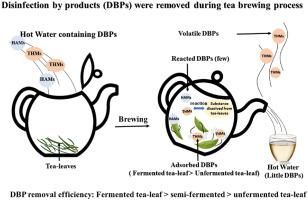Water Research ( IF 11.4 ) Pub Date : 2020-07-07 , DOI: 10.1016/j.watres.2020.116148 Di Zhang 1 , Feifei Wang 2 , Youli Duan 3 , Shenghua Chen 4 , Aihong Zhang 1 , Wenhai Chu 1

|
Disinfection by-products (DBPs) are associated with various adverse health effects. Diversiform advanced treatment processes have been applied for the control of DBPs, but DBPs can still be frequently detected in tap water. Tea-leaves can be made into popular beverage and is itself a porous bio-adsorbent. By simulating tea brewing process, this study evaluated the removal of DBPs from drinking water during the tea brewing process. Removal of four trihalomethanes (THMs) and four haloacetamides (HAMs) by different fermentation degree tea-leaves was investigated. Little DBPs were removed by unfermented and semi-fermented tea-leaves (i.e., Meitan turquoise bud and Dahongpao tea) with less than 5% removal of HAMs, whereas 40% HAMs can be removed by fermented tea (i.e., Jinjunmei tea and Shuixian tea). Tea soup is neutral and slightly acidic, so little DBP hydrolysis was observed under typical tea-leaf brewing process. DBPs were mainly removed by volatilization and adsorption during tea brewing. Removal difference caused by DBP volatilization is very small. The DBP removal difference of four kinds of tea-leaves may be caused by fermentation degree. The surface of unfermented Meitan turquoise bud had a smooth and regular morphology, whereas a rough, irregular, hollow and spongy surface of fermented tea (i.e., Jinjunmei and Shuixian tea) was observed. Generally, the higher the degree of tea fermentation, the more adsorption sites, and the more removal of DBPs. Finally, the model, which takes the DBP initial concentration, tea-leaf dose and brewing time into account, was established under the experimental conditions to predict the variation of DBP concentration during tea brewing, and suggestions for DBP removal were provided to reduce DBP exposure risk. The integrated toxic risk during tea brewing was also investigated, and about 30% integrated cytotoxicity and 26% genotoxicity was reduced during Jinjunmei and Shuixian tea-leaf brewing.
中文翻译:

茶冲泡过程中从饮用水中去除三卤甲烷和卤代乙酰胺:去除机理和动力学分析。
消毒副产物(DBP)与各种不良健康影响有关。多种形式的高级处理工艺已用于控制DBP,但仍可以在自来水中经常检测到DBP。茶叶可以制成受欢迎的饮料,它本身就是一种多孔的生物吸附剂。通过模拟茶的冲泡过程,本研究评估了茶冲泡过程中饮用水中DBP的去除情况。研究了不同发酵度的茶叶对四种三卤甲烷(THMs)和四种卤代乙酰胺(HAMs)的去除。未发酵的和半发酵的茶叶(即湄潭绿松石芽和大红袍茶)去除的DBP很少,而HAM的去除率不到5%,而发酵茶(即金君美茶和水仙茶)可以去除40%的HAMs。 )。茶汤是中性的,略带酸性,因此在典型的茶叶泡制过程中几乎没有观察到DBP水解。冲泡过程中主要通过挥发和吸附去除DBP。DBP挥发引起的去除差异很小。四种茶叶的DBP去除差异可能是由于发酵程度引起的。未发酵的湄潭绿松石芽的表面具有光滑且规则的形态,而观察到的发酵茶(即金均梅和水仙茶)的表面粗糙,不规则,空心且呈海绵状。通常,茶的发酵程度越高,吸附位点越多,DBP的去除也越多。最后,在实验条件下建立了考虑DBP初始浓度,茶叶剂量和冲泡时间的模型,以预测茶叶冲泡过程中DBP浓度的变化,并提供了去除DBP的建议以降低DBP暴露风险。还研究了茶酿造过程中的综合毒性风险,在金俊美和水仙茶酿造过程中降低了约30%的综合细胞毒性和26%的遗传毒性。











































 京公网安备 11010802027423号
京公网安备 11010802027423号